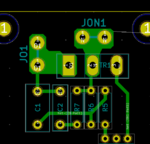PowerIT2020
Newbie level 6

Hello,
I will have a max current of 6 A flows in the PCB, i chosed copper thickness: 2 oz
And i calculated it from: https://www.desmith.net/NMdS/Electronics/TraceWidth.html
It give nearly 70 mil track width for external but 186.74 mil for internal, my pcb will have solder mask layer over the copper layer then which one i should use? (I'll use 70, this will result in overheating?)
I'm confused between what internal and external means? I have only one copper layer at bottom and over it solder mask layer. I'm noob in this, just started.
Thank you.
I will have a max current of 6 A flows in the PCB, i chosed copper thickness: 2 oz
And i calculated it from: https://www.desmith.net/NMdS/Electronics/TraceWidth.html
It give nearly 70 mil track width for external but 186.74 mil for internal, my pcb will have solder mask layer over the copper layer then which one i should use? (I'll use 70, this will result in overheating?)
I'm confused between what internal and external means? I have only one copper layer at bottom and over it solder mask layer. I'm noob in this, just started.
Thank you.





